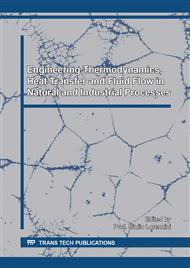[1]
Narei H, Ghasempour R, Noorollahi Y. The effect of employing nanofluid on reducing the bore length of a vertical ground-source heat pump. Energy Convers Manag 2016;123:581–91.
DOI: 10.1016/j.enconman.2016.06.079
Google Scholar
[2]
Wang B, Wang X, Lou W, Hao J. Thermal conductivity and rheological properties of graphite/oil nanofluids. Colloids Surfaces A Physicochem Eng Asp 2012;414:125–31.
DOI: 10.1016/j.colsurfa.2012.08.008
Google Scholar
[3]
Toghraie D, Chaharsoghi VA, Afrand M. Measurement of thermal conductivity of ZnO–TiO2/EG hybrid nanofluid. J Therm Anal Calorim 2016;125:527–35.
DOI: 10.1007/s10973-016-5436-4
Google Scholar
[4]
Ahmadloo E, Azizi S. Prediction of thermal conductivity of various nanofluids using artificial neural network. Int Commun Heat Mass Transf 2016;74:69–75.
DOI: 10.1016/j.icheatmasstransfer.2016.03.008
Google Scholar
[5]
Ahmadi MH, Alhuyi Nazari M, Ghasempour R, Madah H, Shafii MB, Ahmadi MA. Thermal conductivity ratio prediction of Al2O3/water nanofluid by applying connectionist methods. Colloids Surfaces A Physicochem Eng Asp 2018;541:154–64.
DOI: 10.1016/j.colsurfa.2018.01.030
Google Scholar
[6]
Nazari MA, Ghasempour R, Ahmadi MH, Heydarian G, Shafii MB. Experimental investigation of graphene oxide nanofluid on heat transfer enhancement of pulsating heat pipe. Int Commun Heat Mass Transf 2018;91:90–4.
DOI: 10.1016/j.icheatmasstransfer.2017.12.006
Google Scholar
[7]
Ahmadi MH, Mirlohi A, Nazari MA, Ghasempour R. A review of thermal conductivity of various nanofluids. J Mol Liq 2018.
Google Scholar
[8]
Aramesh M, Pourfayaz F, Kasaeian A. Numerical investigation of the nanofluid effects on the heat extraction process of solar ponds in the transient step. Sol Energy 2017;157:869–79.
DOI: 10.1016/j.solener.2017.09.011
Google Scholar
[9]
Manimaran R, Palaniradja K, Alagumurthi N, Hussain J. Experimental comparative study of heat pipe performance using CuO and TiO 2 nanofluids. Int J Energy Res 2014;38:573–80.
DOI: 10.1002/er.3058
Google Scholar
[10]
Wongcharee K, Chuwattanakul V, Eiamsa-ard S. Influence of CuO/water nanofluid concentration and swirling flow on jet impingement cooling. Int Commun Heat Mass Transf 2017.
DOI: 10.1016/j.icheatmasstransfer.2017.08.020
Google Scholar
[11]
Maheshwary PB, Handa CC, Nemade KR. A comprehensive study of effect of concentration, particle size and particle shape on thermal conductivity of titania/water based nanofluid. Appl Therm Eng 2017;119:79–88.
DOI: 10.1016/j.applthermaleng.2017.03.054
Google Scholar
[12]
Hossein Karimi Darvanjooghi M, Nasr Esfahany M. Experimental investigation of the effect of nanoparticle size on thermal conductivity of in-situ prepared silica–ethanol nanofluid. Int Commun Heat Mass Transf 2016;77:148–54.
DOI: 10.1016/j.icheatmasstransfer.2016.08.001
Google Scholar
[13]
Kasaeian A, Ghalamchi M, Ahmadi MH, Ghalamchi M. GMDH algorithm for modeling the outlet temperatures of a solar chimney based on the ambient temperature. Mech Ind 2017;18:216.
DOI: 10.1051/meca/2016034
Google Scholar
[14]
Ahmadi MH, Ahmadi MA, Mehrpooya M, Rosen MA. Using GMDH neural networks to model the power and torque of a stirling engine. Sustain 2015;7:2243–55.
DOI: 10.3390/su7022243
Google Scholar
[15]
Pourkiaei SM, Ahmadi MH, Hasheminejad SM. Modeling and experimental verification of a 25W fabricated PEM fuel cell by parametric and GMDH-type neural network. Mech Ind 2016;17:105.
DOI: 10.1051/meca/2015050
Google Scholar
[16]
Agarwal R, Verma K, Agrawal NK, Duchaniya RK, Singh R. Synthesis, characterization, thermal conductivity and sensitivity of CuO nanofluids. Appl Therm Eng 2016;102:1024–36.
DOI: 10.1016/j.applthermaleng.2016.04.051
Google Scholar
[17]
Liu M, Lin M, Wang C. Enhancements of thermal conductivities with Cu, CuO, and carbon nanotube nanofluids and application of MWNT/water nanofluid on a water chiller system. Nanoscale Res Lett 2011;6:297.
DOI: 10.1186/1556-276x-6-297
Google Scholar
[18]
Wang X, Xu X, S. Choi SU. Thermal Conductivity of Nanoparticle - Fluid Mixture. J Thermophys Heat Transf 1999;13:474–80.
Google Scholar
[19]
Lee S, Choi SU-S, Li S, Eastman JA. Measuring Thermal Conductivity of Fluids Containing Oxide Nanoparticles. J Heat Transfer 1999;121:280.
DOI: 10.1115/1.2825978
Google Scholar
[20]
Liu MS, Lin MCC, Huang I Te, Wang CC. Enhancement of thermal conductivity with CuO for nanofluids. Chem Eng Technol 2006;29:72–7.
Google Scholar


